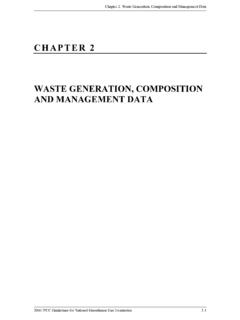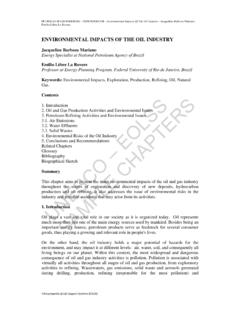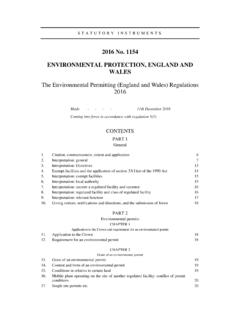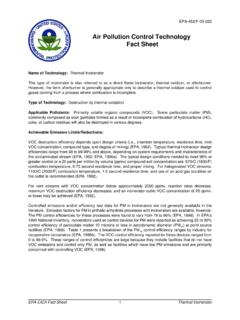Transcription of AP-42, Appendix B.2 Generalized Particle Size Distributions
1 Appendix Generalized Particle size Distributions . 9/90 (Reformatted 1/95) Appendix EMISSION FACTORS (Reformatted 1/95) 9/90. CONTENTS. Page Rationale For Developing Generalized Particle size Distributions .. How to Use The Generalized Particle size Distributions for Uncontrolled Processes .. How to Use The Generalized Particle size Distributions for Controlled Processes .. Example Calculation .. References .. 9/90 (Reformatted 1/95) Appendix EMISSION FACTORS (Reformatted 1/95) 9/90. Appendix Generalized Particle size Distributions Rationale For Developing Generalized Particle size Distributions The preparation of size -specific particulate emission inventories requires size distribution information for each process. Particle size Distributions for many processes are contained in appropriate industry sections of this document.
2 Because Particle size information for many processes of local impact and concern are unavailable, this Appendix provides "generic" Particle size Distributions applicable to these processes. The concept of the "generic" Particle size distribution is based on categorizing measured Particle size data from similar processes generating emissions from similar materials. These generic Distributions have been developed from sampled size Distributions from about 200 sources. Generic Particle size Distributions are approximations. They should be used only in the absence of source-specific Particle size Distributions for areawide emission inventories. How To Use The Generalized Particle size Distributions For Uncontrolled Processes Figure provides an example calculation to assist the analyst in preparing Particle size - specific emission estimates using generic size Distributions .
3 The following instructions for the calculation apply to each particulate emission source for which a Particle size distribution is desired and for which no source specific Particle size information is given elsewhere in this document: 1. Identify and review the AP-42 section dealing with that process. 2. Obtain the uncontrolled particulate emission factor for the process from the main text of AP-42, and calculate uncontrolled total particulate emissions. 3. Obtain the category number of the appropriate generic Particle size distribution from Table 4. Obtain the Particle size distribution for the appropriate category from Table Apply the Particle size distribution to the uncontrolled particulate emissions. Instructions for calculating the controlled size -specific emissions are given in Table and illustrated in Figure 9/90 (Reformatted 1/95) Appendix Figure Example calculation for determining uncontrolled and controlled Particle size -specific emissions.
4 SOURCE IDENTIFICATION. Source name and address: ABC Brick Manufacturing 24 Dusty Way Anywhere, USA. Process description: Dryers/Grinders AP-42 Section: , Bricks And Related Clay Products Uncontrolled AP-42. emission factor: 96 lbs/ton (units). Activity parameter: 63,700 tons/year (units). Uncontrolled emissions: tons/year (units). UNCONTROLLED size EMISSIONS. Category name: Mechanically Generated/Aggregated, Unprocessed Ores Category number: 3. Particle size ( m). 6 10. Generic distribution, Cumulative percent equal to or less than the size : 15 34 51. Cumulative mass Particle size emissions (tons/year): CONTROLLED size EMISSIONS*. Type of control device: Fabric Filter Particle size ( m). 0 - - 6 6 - 10. Collection efficiency (Table ): Mass in size range** before control (tons/year): Mass in size range after control (tons/year): Cumulative mass (tons/year): * These data do not include results for the greater than 10 m Particle size range.
5 ** Uncontrolled size data are cumulative percent equal to or less than the size . Control efficiency data apply only to size range and are not cumulative. EMISSION FACTORS (Reformatted 1/95) 9/90. Table Particle size CATEGORY BY AP-42 SECTION. AP-42 Category AP-42 Category Section Source Category Number* Section Source Category Number*. External combustion Ammonium phosphates Bituminous and subbituminous coal a Reactor/ammoniator-granulator 4. combustion Dryer/cooler 4. Anthracite coal combustion a Hydrofluoric acid Fuel oil combustion Spar drying 3. Residual oil Spar handling 3. Utility a Transfer 3. Commercial a Phosphoric acid (thermal process) a Distillate oil Sulfuric acid b Utility a Sodium carbonate a Commercial a Food and agricultural Residential a Defoliation and harvesting of cotton Natural gas combustion a Trailer loading 6.
6 Liquefied petroleum gas a Transport 6. Wood waste combustion in boilers a Harvesting of grain Lignite combustion a Harvesting machine 6. Bagasse combustion b Truck loading 6. Residential fireplaces a Field transport 6. Residential wood stoves a Meat smokehouses 9. Waste oil combustion a Cotton ginning b Solid waste disposal Grain elevators and processing plants a Refuse combustion a Alfalfa dehydrating Sewage sludge incineration a Primary cyclone b Conical burners (wood waste) 2 Meal collector cyclone 7. Internal combustion engines Pellet cooler cyclone 7. Highway vehicles c Pellet regrind cyclone 7. Off highway vehicles 1 Starch manufacturing 7. Organic chemical processes Fermentation 6,7. Paint and varnish 4 Coffee roasting 6. Phthalic anhydride 9 Wood products Soap and detergents a Chemical wood pulping a Inorganic chemical processes Charcoal 9.
7 Urea a Mineral products Ammonium nitrate fertilizers a Hot mix asphalt plants a Ammonium sulfate Bricks and related clay products Rotary dryer b Raw materials handling Fluidized bed dryer b Dryers, grinders, etc. b Phosphate fertilizers 3. 9/90 (Reformatted 1/95) Appendix Table (cont.). AP-42 Category AP-42 Category Section Source Category Number* Section Source Category Number*. Tunnel/periodic kilns Gypsum manufacturing Gas fired a Rotary ore dryer a Oil fired a Roller mill 4. Coal fired a Impact mill 4. Refractory manufacturing Flash calciner a Raw material dryer 3 Continuous kettle calciner a Raw material crushing and screening 3 Lime manufacturing a Electric arc melting 8 Mineral wool manufacturing Curing oven 3 Cupola 8. Portland cement manufacturing Reverberatory furnace 8. Dry process Blow chamber 8.
8 Kilns a Curing oven 9. Dryers, grinders, etc. 4 Cooler 9. Wet process Sand and gravel processing Kilns a Continuous drop Dryers, grinders, etc. 4 Transfer station a Ceramic clay manufacturing Pile formation - stacker a Drying 3 Batch drop a Grinding 4 Active storage piles a Storage 3 Vehicle traffic on unpaved road a Clay and fly ash sintering Crushed stone processing Fly ash sintering, crushing, Dry crushing screening, yard storage 5 Primary crushing a Clay mixed with coke Secondary crushing and screening a Crushing, screening, yard storage 3 Tertiary crushing and screening 3. Western surface coal mining a Recrushing and screening 4. Coal cleaning 3 Fines mill 4. Concrete batching 3 Screening, conveying, handling a Glass fiber manufacturing Phosphate rock processing Unloading and conveying 3 Drying a Storage bins 3 Calcining a Mixing and weighing 3 Grinding b Glass furnace - wool a Transfer and storage 3.
9 Glass furnace - textile a Taconite ore processing Glass manufacturing a Fine crushing 4. EMISSION FACTORS (Reformatted 1/95) 9/90. Table (cont.). AP-42 Category AP-42 Category Section Source Category Number* Section Source Category Number*. Waste gas a Zinc smelting 8. Pellet handling 4 Secondary aluminum operations Grate discharge 5 Sweating furnace 8. Grate feed 4 Smelting Bentonite blending 4 Crucible furnace 8. Coarse crushing 3 Reverberatory furnace a Ore transfer 3 Secondary copper smelting Bentonite transfer 4 and alloying 8. Unpaved roads a Gray iron foundries a Metallic minerals processing a Secondary lead processing a Metallurgical Secondary magnesium smelting 8. Primary aluminum production Steel foundries - melting b Bauxite grinding 4 Secondary zinc processing 8. Aluminum hydroxide calcining 5 Storage battery production b Anode baking furnace 9 Leadbearing ore crushing and grinding 4.
10 Prebake cell a Miscellaneous sources Vertical Soderberg 8 Wildfires and prescribed burning a Horizontal Soderberg a Fugitive dust a Coke manufacturing a Primary copper smelting a Ferroalloy production a Iron and steel production Blast furnace Slips a Cast house a Sintering Windbox a Sinter discharge a Basic oxygen furnace a Electric arc furnace a Primary lead smelting a * Data for numbered categories are given Table Particle size data on "a" categories are found in the AP-42 text; for "b" categories, in Appendix ; and for "c" categories, in AP-42 Volume II: Mobile Sources. 9/90 (Reformatted 1/95) Appendix Figure CALCULATION SHEET. SOURCE IDENTIFICATION. Source name and address: Process description: AP-42 Section: Uncontrolled AP-42. emission factor: (units). Activity parameter: (units). Uncontrolled emissions: (units).















